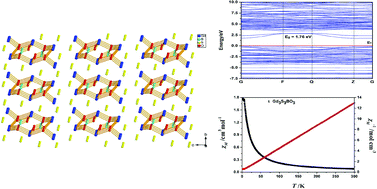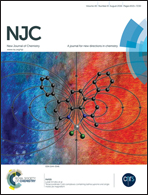Crystal and electronic structures, and optical and magnetic properties of novel rare-earth sulfide borates RE3S3BO3 (RE = Sm, Gd)†
Abstract
Two isostructural quaternary rare-earth sulfide borates Gd3S3BO3 (1) and Sm3S3BO3 (2) were synthesized by a high temperature solid-state method. They crystallize in the triclinic space group P![[1 with combining macron]](https://www.rsc.org/images/entities/char_0031_0304.gif) and represent a rarely studied structure type. Their structures feature a 1D infinite {[RE6(BO3)2]12+}∞ chain constructed by the connection between RE ions and trigonal planar unit (BO3)3− anions, and S atoms occupying the trigonal bipyramid or tetragonal pyramid inter-spaces between the {[RE6(BO3)2]12+}∞ chains. Their structures can be recognized as a 1 : 1 intergrowth of Gd2S3- and Gd(BO3)-like slabs, and this trait of the crystal chemistry is discussed. The optical energy gap of 1 is determined to be 2.65 eV, which is consistent with the result of the theoretical calculation. The calculation indicates that 1 is an indirect semiconductor, and its optical absorption is mainly ascribed to the charge transition from the S 3p to Gd 5d states. Compound 1 demonstrates antiferromagnetic behavior under low temperatures and orders at around 5.9 K, while 2 behaves with typical Van Vleck-type paramagnetism.
and represent a rarely studied structure type. Their structures feature a 1D infinite {[RE6(BO3)2]12+}∞ chain constructed by the connection between RE ions and trigonal planar unit (BO3)3− anions, and S atoms occupying the trigonal bipyramid or tetragonal pyramid inter-spaces between the {[RE6(BO3)2]12+}∞ chains. Their structures can be recognized as a 1 : 1 intergrowth of Gd2S3- and Gd(BO3)-like slabs, and this trait of the crystal chemistry is discussed. The optical energy gap of 1 is determined to be 2.65 eV, which is consistent with the result of the theoretical calculation. The calculation indicates that 1 is an indirect semiconductor, and its optical absorption is mainly ascribed to the charge transition from the S 3p to Gd 5d states. Compound 1 demonstrates antiferromagnetic behavior under low temperatures and orders at around 5.9 K, while 2 behaves with typical Van Vleck-type paramagnetism.


 Please wait while we load your content...
Please wait while we load your content...